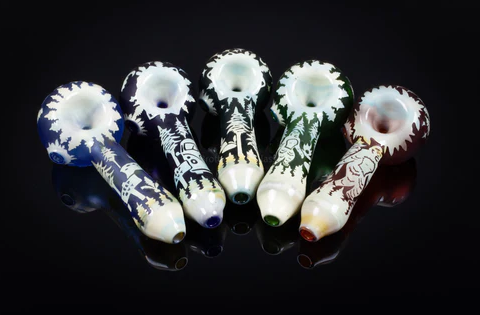Weed Pipes are an American Culture

Weed is widely consumed among adults and adolescents in America. Following the legalization of cannabis for recreational and medical uses in some states, more people are showing interest in marijuana.
With the growth in cannabis consumption, there is also a growth in the availability and usage of weed pipes. Today, it is common knowledge that weed pipes are ingrained in the American culture.
What does Cannabis Culture Mean?
Cannabis culture refers to a social ambiance or series of social behaviors associated with the consumption of cannabis, especially as a medicine and recreational drug. Historically, marijuana is utilized as an entheogen to invoke spiritual experiences.
The entheogenic usage of cannabis was recorded among the Germanic peoples, the Celts, Ancient China, Africa, and Ancient Central Asia. Although the introduction of marijuana and weed pipes to American culture was much later, Americans have embraced and ingrained weed into its existence.
The consumption of marijuana is more than an idiosyncratic feature in America; it has become an integral part of the people and culture of the region.
The History of Weed Pipes in America
The history of weed pipes and everything cannabis dates back to the ancient years. Weed pipes have been in use for centuries for different smoking needs. They come in different materials and today, glass pipes are some of the most popular options available in the market.
Back in history, weed pipes were made of diverse materials but not glass. Clay was the first material used in making pipes. Apart from clay pipes, other weed pipes were designed and made available to ancient stoners. Some options available include wooden pipes, metal pipes, and so on.
With time, glass weed pipes were introduced and today, they have taken over the market. Looking at history, it is obvious that weed smoking is not a relatively new culture in America. It is ingrained in the culture and history of the people even long before legalization was a topic.
How Cannabis and Weed Pipes have fared in America Culture
Of course, it has not been all rosy and smooth ride for cannabis and all its paraphernalia since it made its appearance on the American scene during the colonial era. It has gone through some trying times, with many pioneers lending their voices and suffering for it.
The first glass weed pipe came into the market in the 70s but since marijuana was still illegal, the devices also became illegal. Interestingly, the illegality of cannabis and weed pipes did not stop Americans from consuming their favorite products.
The threats against marijuana and its consumption were so strong that many went to jail for associating with it. Still, all these did not deter people from taking marijuana both for medical and recreational purposes.
In the early 2000s, the federal government clamped down on retailers and consumers of cannabis devices and accessories. The government forbade the sale of weed pipes and seized many pieces from retailers.
Stoners did not give up on the fight against marijuana and years later, the restrictions on cannabis began to ease. Many states began to legalize the consumption of cannabis for medical purposes. Glass pipes also got their freedom and became a popular choice among American stoners.
Weed Pipes and the American Culture: the Merging Point
It’s impossible to talk about weed pipes without focusing on cannabis itself. So, while exploring how weed pipes have become an integral part of the American culture, the focus on cannabis itself is inevitable.
The modern marijuana culture took a defining structure in the 1960s during the glory years of contemporary cannabis culture. At this time, the peak of the hippie revolution in America and the culture of cannabis at work in the USA became the focal point.
Weed, and by extension, weed pipes, found their way into the limelight riding on the different aspects of the people’s lives. Marijuana began to be featured in holidays, music (especially reggae, rap, jazz, and psychedelia), cinema (including stoner movie genres), and magazines.
It wasn’t long before cannabis culture penetrated chess culture. Although not legalized yet, many people began to crave the ownership of weed pipes. Before long, weed pipes became a symbol of belonging.
The Hippie and Hipster Era
The hippie and hipster culture is embedded in weed and its paraphernalia. The hippies followed a culture where marijuana consumption was associated with a special subculture. The weed pipes were popular with the hippies who consumed cannabis and considered it benign and pleasurable.
Following this group were the hipsters of 1940. Hipsters define two different cultural groups – the 40s culture devoted to jazz and the modern culture as it is known today.
Both groups are stereotyped as great users of weed pipes. As a fact, the language of the early hipsters of the 40s was inundated with heavy use of slang associated with weed and its distribution.
The Future of Weed and Weed Pipes
Weed pipes have endured the dark times and with the legalization of cannabis and higher social acceptance, the story is being recreated. Pipes have become legal devices for the consumption of tobacco. Cannabis has also been legalized in some states for both medicinal and recreational use.
That means manufacturers can tap into their creativity to produce weed pipes that will delight the American stoners. Currently, there is an abundance of pipes that stoners can explore, including hand weed pipes, bubbler pipes, bongs, and so much more.
Pipes have undoubtedly come a long way and have successfully infiltrated the American culture. It is not likely that the wars that have been won will resurface. Instead, Americans can expect the evolution of weed pipes as more states join in the legalization of cannabis usage in the country.
Conclusion
The legal and societal landscape associated with marijuana has significantly changed in the last few decades and the changes are likely to continue. With the positive attitudes toward weed, there will be more adoption of weed pipes and their integration into the culture of the people.





